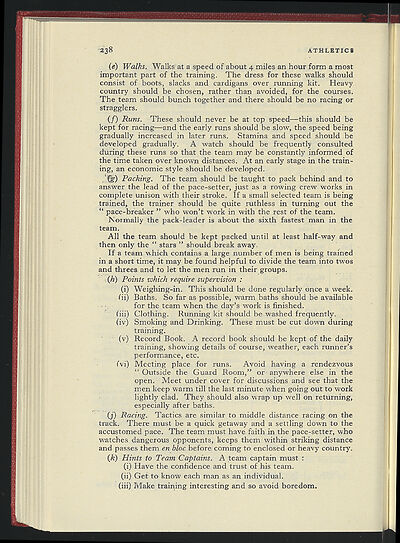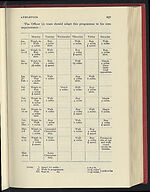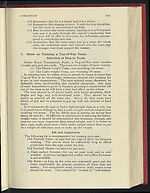1957-58
(252)
Download files
Complete book:
Individual page:
Thumbnail gallery: Grid view | List view

238 ATHLETICY
(e) Walks.
Walks
-
at a speed of about 4 miles an hour form a most
important part of the training. The dress for these walks should
consist of boots, slacks and cardigans over running kit. Heavy
country should be chosen, rather than avoided, for the courses.
The
.
team should bunch together and there should be no racing or
stragglers.
(f) Runs.
These should never be at top speed—this should be
kept for racing—and the early runs should be slow, the speed being
gradually increased in later runs. Stamina and speed .should be
de-veloped gradually. ' A watch should be frequently consulted
during these runs so that the team .may be constantly informed of
the time taken over known distances. At an early stage in the train-
ing, an economic style should be developed.
,`��) Packing.
The team should be taught to pack behind and to
answer the lead of the pace-setter, just as a rowing crew works in
complete unison with their stroke. If a small selected team is being
trained, the trainer should be quite ruthless in turning out the
" pace-breaker " who won't work in with the rest of the team.
Normally the pack-leader is about the sixth fastest man in the
team.
All the team should be kept packed until at least half-way and
then only the " stars " should break away.
If a team which contains a large number of men is being trained
in a short time, it may be found helpful to divide the team into twos
and d threes and to let the men run in their groups.
(h) Points which require supervision
(i) Weighing-in. This should be done regularly once a week.
(ii) Baths. So far as possible, warm baths should be available
for the team when the day's work is finished.
(iii) Clothing. Running kit should be washed frequently.
(iv) Smoking and Drinking. These must be cut down during
training. .
(v) Record Book. A record book should be kept of the daily
training, showing details of course, weather, each runner's
performance, etc.
(vi) Meeting place for runs. Avoid having a rendezvous
" Outside the Guard Room," or
,
anywhere else in the
open. Meet under cover for discussions and see that the
men keep warm till the last minute when going out to work
lightly clad. They should also wrap up well on returning,
especially after baths.
(j) Racing.
Tactics are similar to middle distance racing on the
track. There must be a quick getaway and a settling down to the
accustomed pace. The team must have faith in the pace-setter, who
watches dangerous opponents, keeps them within striking distance
and passes them
en bloc
before coming to enclosed or heavy country.
(k) Hints to Team Captains.
A team captain must
(i) Have the confidence and trust of his team.
(ii) Get to know each man as an individual.
(iii) Make training interesting and so avoid boredom.
(e) Walks.
Walks
-
at a speed of about 4 miles an hour form a most
important part of the training. The dress for these walks should
consist of boots, slacks and cardigans over running kit. Heavy
country should be chosen, rather than avoided, for the courses.
The
.
team should bunch together and there should be no racing or
stragglers.
(f) Runs.
These should never be at top speed—this should be
kept for racing—and the early runs should be slow, the speed being
gradually increased in later runs. Stamina and speed .should be
de-veloped gradually. ' A watch should be frequently consulted
during these runs so that the team .may be constantly informed of
the time taken over known distances. At an early stage in the train-
ing, an economic style should be developed.
,`��) Packing.
The team should be taught to pack behind and to
answer the lead of the pace-setter, just as a rowing crew works in
complete unison with their stroke. If a small selected team is being
trained, the trainer should be quite ruthless in turning out the
" pace-breaker " who won't work in with the rest of the team.
Normally the pack-leader is about the sixth fastest man in the
team.
All the team should be kept packed until at least half-way and
then only the " stars " should break away.
If a team which contains a large number of men is being trained
in a short time, it may be found helpful to divide the team into twos
and d threes and to let the men run in their groups.
(h) Points which require supervision
(i) Weighing-in. This should be done regularly once a week.
(ii) Baths. So far as possible, warm baths should be available
for the team when the day's work is finished.
(iii) Clothing. Running kit should be washed frequently.
(iv) Smoking and Drinking. These must be cut down during
training. .
(v) Record Book. A record book should be kept of the daily
training, showing details of course, weather, each runner's
performance, etc.
(vi) Meeting place for runs. Avoid having a rendezvous
" Outside the Guard Room," or
,
anywhere else in the
open. Meet under cover for discussions and see that the
men keep warm till the last minute when going out to work
lightly clad. They should also wrap up well on returning,
especially after baths.
(j) Racing.
Tactics are similar to middle distance racing on the
track. There must be a quick getaway and a settling down to the
accustomed pace. The team must have faith in the pace-setter, who
watches dangerous opponents, keeps them within striking distance
and passes them
en bloc
before coming to enclosed or heavy country.
(k) Hints to Team Captains.
A team captain must
(i) Have the confidence and trust of his team.
(ii) Get to know each man as an individual.
(iii) Make training interesting and so avoid boredom.
Set display mode to:
![]() Universal Viewer |
Universal Viewer | ![]() Mirador |
Large image | Transcription
Mirador |
Large image | Transcription
| Games and sports in the army > 1957-58 > (252) |
|---|
| Permanent URL | https://digital.nls.uk/248854273 |
|---|
| Description | 'Games and Sports in the Army' was an annual publication produced by the British War Office between the 1930s and 1960s. This included the Second World War. It outlines the rules and regulations for games and sports played by members of the armed forces. It features names and photographs of team members, and examples of contemporary advertising. |
|---|---|
| Shelfmark | GWB.52 |

